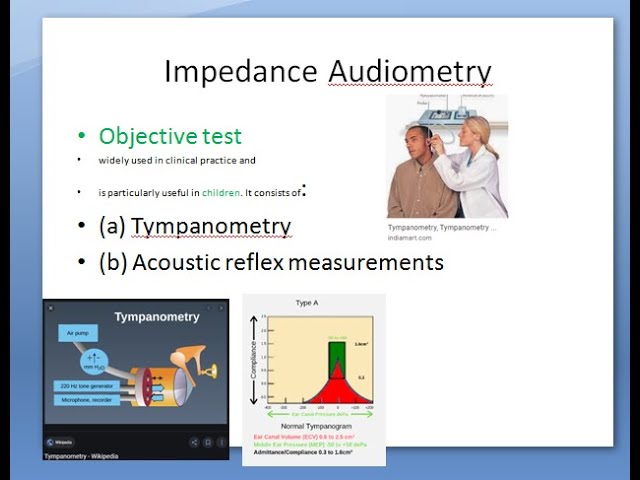Understanding Tympanometry: A Comprehensive Guide to Ear Health
Tympanometry is a valuable diagnostic tool used in the field of audiology and otolaryngology to assess the health and function of the middle ear. This non-invasive test provides essential insights into the condition of the ear and is commonly employed to diagnose various ear-related issues. In this comprehensive guide, we will delve into what tympanometry entails, how it works, and why it plays a pivotal role in maintaining ear health.

What Is Tympanometry?
Tympanometry, often referred to as a “tympanogram,” is a diagnostic procedure that evaluates the compliance and mobility of the eardrum, or tympanic membrane, as well as the pressure within the middle ear. It involves the use of a specialized device called a tympanometer, which emits varying air pressure levels into the ear canal while measuring the resulting changes in the eardrum’s movement. These measurements are then graphically represented in a tympanogram.
The Significance of Tympanometry
Tympanometry serves multiple critical purposes in ear health assessment and diagnosis:
Identifying Middle Ear Problems:
Tympanometry aids in detecting various middle ear issues, such as fluid buildup (effusion), ear infections (otitis media), and eustachian tube dysfunction. By assessing the eardrum’s response to pressure changes, healthcare providers can pinpoint the underlying problems.
Evaluating Eustachian Tube Function:
The eustachian tubes are responsible for equalizing air pressure between the middle ear and the external environment. Tympanometry can reveal any abnormalities in eustachian tube function, helping to diagnose conditions like barotrauma or chronic ear infections.
Monitoring Middle Ear Health:
Tympanometry is not only diagnostic but also useful for ongoing monitoring of middle ear health. It allows healthcare providers to track changes in ear conditions over time, ensuring timely intervention when needed.
The Tympanometry Procedure: What Happens During the Test
Tympanometry is a painless and straightforward procedure typically performed by audiologists or ear specialists. Here’s what you can expect during a tympanometry test:
Preparation:
Before the test, the audiologist will ensure that your ear canal is clear of obstructions and wax. It’s essential to have clean ear canals for accurate results.
Instrument Placement:
You will be comfortably seated, and a small, soft tip will be gently placed at the entrance of your ear canal. This tip contains a microphone and speaker, allowing the tympanometer to send and receive sound waves.
Pressure Variations:
The audiologist will introduce a series of air pressure changes into your ear canal. You may hear slight tones or feel pressure fluctuations. These variations are entirely normal and part of the test.
Interpreting Tympanometry Results
Understanding the results of a tympanometry test is essential in assessing ear health and diagnosing specific conditions. Here are some common tympanogram patterns and their interpretations:
Type A Tympanogram:
This is considered normal. It indicates that the eardrum and middle ear are functioning correctly. The peak of the tympanogram is within the normal pressure range.
Type B Tympanogram:
This pattern suggests the presence of middle ear issues, such as fluid buildup, infection, or eustachian tube dysfunction. Further evaluation is typically required to identify the specific problem.
Type C Tympanogram:
A Type C tympanogram indicates negative middle ear pressure, often associated with eustachian tube dysfunction. It may require monitoring or treatment to restore proper pressure.
Diagnosing Ear Conditions with Tympanometry
Tympanometry is instrumental in diagnosing various ear conditions. Here are some of the common conditions that can be identified through tympanometry:
Otitis Media (Middle Ear Infection):
Tympanometry can detect the presence of fluid in the middle ear, a hallmark of otitis media. Different tympanogram patterns may suggest acute or chronic infections.
Eustachian Tube Dysfunction:
When the eustachian tubes fail to equalize pressure properly, it can result in a Type C tympanogram. Tympanometry helps diagnose this dysfunction, which can lead to ear discomfort and hearing issues.
Fluid Accumulation (Effusion):
Effusion or the buildup of fluid in the middle ear can cause hearing problems, especially in children. Tympanometry can identify this condition and guide treatment decisions.
The Role of Tympanometry in Ear Health Management
Tympanometry is not only a diagnostic tool but also an essential component of ear health management. Here’s why it plays a crucial role:
Timely Intervention:
By detecting ear conditions early, tympanometry allows for timely intervention. This can prevent issues from worsening and minimize discomfort.
Treatment Monitoring:
For individuals with chronic ear conditions like recurrent otitis media, tympanometry helps monitor treatment effectiveness and guides adjustments when necessary.
Pediatric Ear Health:
Tympanometry is especially valuable in pediatric care, where ear issues can impact language development and learning. Early detection and management are critical for children’s well-being.
Tympanometry FAQs
1. What is tympanometry?
Tympanometry is a diagnostic test that assesses the health and function of the middle ear. It measures the compliance and pressure of the eardrum and can help diagnose various ear conditions.
2. Is tympanometry painful?
No, tympanometry is generally painless. You may feel slight pressure changes and hear sounds, but it should not be painful.
3. Why might my doctor recommend tympanometry?
Tympanometry is recommended to diagnose and monitor conditions like ear infections, fluid buildup in the middle ear, and eustachian tube dysfunction.
4. How long does a tympanometry test take?
A tympanometry test typically takes just a few minutes to complete.
5. Can children undergo tympanometry?
Yes, tympanometry is safe for children and is often used to assess their ear health.
6. What happens if I have a Type B tympanogram?
A Type B tympanogram suggests middle ear issues. Further evaluation is needed to identify the specific problem.
7. Are there any preparations required before a tympanometry test?
It’s advisable to keep your ear canals clean. Inform your audiologist about any medications you’re taking.
8. Can I eat or drink before a tympanometry test?
Yes, you can eat and drink normally before the test. There are no dietary restrictions.
9. Are there any risks associated with tympanometry?
Tympanometry is considered safe and carries minimal risks. It’s a non-invasive procedure.
10. Can tympanometry diagnose hearing loss?
While tympanometry provides valuable information about middle ear function, it primarily assesses conditions related to the middle ear, not sensorineural hearing loss. Additional tests may be needed to diagnose hearing loss.
Conclusion:
In conclusion, tympanometry is a powerful tool for assessing ear health, diagnosing conditions, and ensuring timely intervention. If you or a loved one is experiencing ear-related concerns, consult an audiologist or healthcare provider for a thorough evaluation and, if needed, a tympanometry test.




